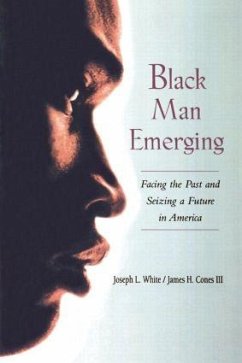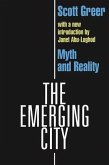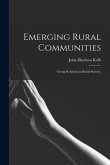Joseph L. White, James H. Cones III
Black Man Emerging
Facing the Past and Seizing a Future in America
Joseph L. White, James H. Cones III
Black Man Emerging
Facing the Past and Seizing a Future in America
- Broschiertes Buch
- Merkliste
- Auf die Merkliste
- Bewerten Bewerten
- Teilen
- Produkt teilen
- Produkterinnerung
- Produkterinnerung
First published in 2000. Routledge is an imprint of Taylor & Francis, an informa company.
Andere Kunden interessierten sich auch für
![Can Emerging Technologies Make a Difference in Development? Can Emerging Technologies Make a Difference in Development?]() Can Emerging Technologies Make a Difference in Development?72,99 €
Can Emerging Technologies Make a Difference in Development?72,99 €![The Emerging City The Emerging City]() Scott GreerThe Emerging City44,99 €
Scott GreerThe Emerging City44,99 €![Emerging Adulthood Emerging Adulthood]() Jeffrey Jensen ArnettEmerging Adulthood39,99 €
Jeffrey Jensen ArnettEmerging Adulthood39,99 €![Emerging Rural Communities Emerging Rural Communities]() John Harrison KolbEmerging Rural Communities21,99 €
John Harrison KolbEmerging Rural Communities21,99 €![Emerging from Turbulence Emerging from Turbulence]() Leon GrunbergEmerging from Turbulence39,99 €
Leon GrunbergEmerging from Turbulence39,99 €![The Emerging Network The Emerging Network]() Michael YorkThe Emerging Network98,99 €
Michael YorkThe Emerging Network98,99 €![Man & Soc Age Reconstructn V 2 Man & Soc Age Reconstructn V 2]() Karl MannheimMan & Soc Age Reconstructn V 274,99 €
Karl MannheimMan & Soc Age Reconstructn V 274,99 €-
-
-
First published in 2000. Routledge is an imprint of Taylor & Francis, an informa company.
Hinweis: Dieser Artikel kann nur an eine deutsche Lieferadresse ausgeliefert werden.
Hinweis: Dieser Artikel kann nur an eine deutsche Lieferadresse ausgeliefert werden.
Produktdetails
- Produktdetails
- Verlag: Routledge
- Seitenzahl: 350
- Erscheinungstermin: 22. September 1999
- Englisch
- Abmessung: 229mm x 152mm x 19mm
- Gewicht: 508g
- ISBN-13: 9780415925723
- ISBN-10: 041592572X
- Artikelnr.: 22188952
- Herstellerkennzeichnung
- Libri GmbH
- Europaallee 1
- 36244 Bad Hersfeld
- gpsr@libri.de
- Verlag: Routledge
- Seitenzahl: 350
- Erscheinungstermin: 22. September 1999
- Englisch
- Abmessung: 229mm x 152mm x 19mm
- Gewicht: 508g
- ISBN-13: 9780415925723
- ISBN-10: 041592572X
- Artikelnr.: 22188952
- Herstellerkennzeichnung
- Libri GmbH
- Europaallee 1
- 36244 Bad Hersfeld
- gpsr@libri.de
Joseph L. White is Professor Emeritus of Psychology and Psychiatry at the University of California, Irvine and the recipient of the 1994 Citation of Achievement in Psychology and Community Service from President Bill Clinton., James H. Cones III works at the University of California, Irvine, where he is Lecturer in Psychology and African American Studies and Clinical Services Director and Assistant Director of the Counseling Center. He is also Lecturer in Women's Studies and African American Studies at UCLA.
Part I The Present and the Past: Current Voices1 Historical Traces
Chapter 1 Introduction
Chapter 2 Beginnings
Chapter 3 An Opposing View: The Black Construction of Social Reality
Part II Contemporary Images and Expressive Styles
Chapter 4 Contemporary Black Male Images: A One-Sided View
Chapter 5 Cool Pose, Rap, Hip-Hop, and the Black Aesthetic
Part III The African-American Male: Masculine Alternatives and Psycological Challenges
Chapter 6 Masculine Alternatives: The African-American Perspective
Chapter 7 The Black Male: Major Psychological Challenges
Chapter 8 Biographical Memoirs I
Chapter 9 Biographical Memoirs II Searchers and Achievers
Part IV Major Influences on African-American Masculine Development
Chapter 10 The Influence of the Family
Chapter 11 The Role of the Peer Group
Chapter 12 Neighborhood Influences on Black Masculine Development
Part V Interventions, Recommendations, and Conclusions
Chapter 13 Fatherhood, Manhood Training, and Education
Chapter 14 High-Risk Youth, Rehabilitation, and Extending Outreach
Chapter 15 What Next? Confronting Racism
Chapter 1 Introduction
Chapter 2 Beginnings
Chapter 3 An Opposing View: The Black Construction of Social Reality
Part II Contemporary Images and Expressive Styles
Chapter 4 Contemporary Black Male Images: A One-Sided View
Chapter 5 Cool Pose, Rap, Hip-Hop, and the Black Aesthetic
Part III The African-American Male: Masculine Alternatives and Psycological Challenges
Chapter 6 Masculine Alternatives: The African-American Perspective
Chapter 7 The Black Male: Major Psychological Challenges
Chapter 8 Biographical Memoirs I
Chapter 9 Biographical Memoirs II Searchers and Achievers
Part IV Major Influences on African-American Masculine Development
Chapter 10 The Influence of the Family
Chapter 11 The Role of the Peer Group
Chapter 12 Neighborhood Influences on Black Masculine Development
Part V Interventions, Recommendations, and Conclusions
Chapter 13 Fatherhood, Manhood Training, and Education
Chapter 14 High-Risk Youth, Rehabilitation, and Extending Outreach
Chapter 15 What Next? Confronting Racism
Part I The Present and the Past: Current Voices1 Historical Traces
Chapter 1 Introduction
Chapter 2 Beginnings
Chapter 3 An Opposing View: The Black Construction of Social Reality
Part II Contemporary Images and Expressive Styles
Chapter 4 Contemporary Black Male Images: A One-Sided View
Chapter 5 Cool Pose, Rap, Hip-Hop, and the Black Aesthetic
Part III The African-American Male: Masculine Alternatives and Psycological Challenges
Chapter 6 Masculine Alternatives: The African-American Perspective
Chapter 7 The Black Male: Major Psychological Challenges
Chapter 8 Biographical Memoirs I
Chapter 9 Biographical Memoirs II Searchers and Achievers
Part IV Major Influences on African-American Masculine Development
Chapter 10 The Influence of the Family
Chapter 11 The Role of the Peer Group
Chapter 12 Neighborhood Influences on Black Masculine Development
Part V Interventions, Recommendations, and Conclusions
Chapter 13 Fatherhood, Manhood Training, and Education
Chapter 14 High-Risk Youth, Rehabilitation, and Extending Outreach
Chapter 15 What Next? Confronting Racism
Chapter 1 Introduction
Chapter 2 Beginnings
Chapter 3 An Opposing View: The Black Construction of Social Reality
Part II Contemporary Images and Expressive Styles
Chapter 4 Contemporary Black Male Images: A One-Sided View
Chapter 5 Cool Pose, Rap, Hip-Hop, and the Black Aesthetic
Part III The African-American Male: Masculine Alternatives and Psycological Challenges
Chapter 6 Masculine Alternatives: The African-American Perspective
Chapter 7 The Black Male: Major Psychological Challenges
Chapter 8 Biographical Memoirs I
Chapter 9 Biographical Memoirs II Searchers and Achievers
Part IV Major Influences on African-American Masculine Development
Chapter 10 The Influence of the Family
Chapter 11 The Role of the Peer Group
Chapter 12 Neighborhood Influences on Black Masculine Development
Part V Interventions, Recommendations, and Conclusions
Chapter 13 Fatherhood, Manhood Training, and Education
Chapter 14 High-Risk Youth, Rehabilitation, and Extending Outreach
Chapter 15 What Next? Confronting Racism








